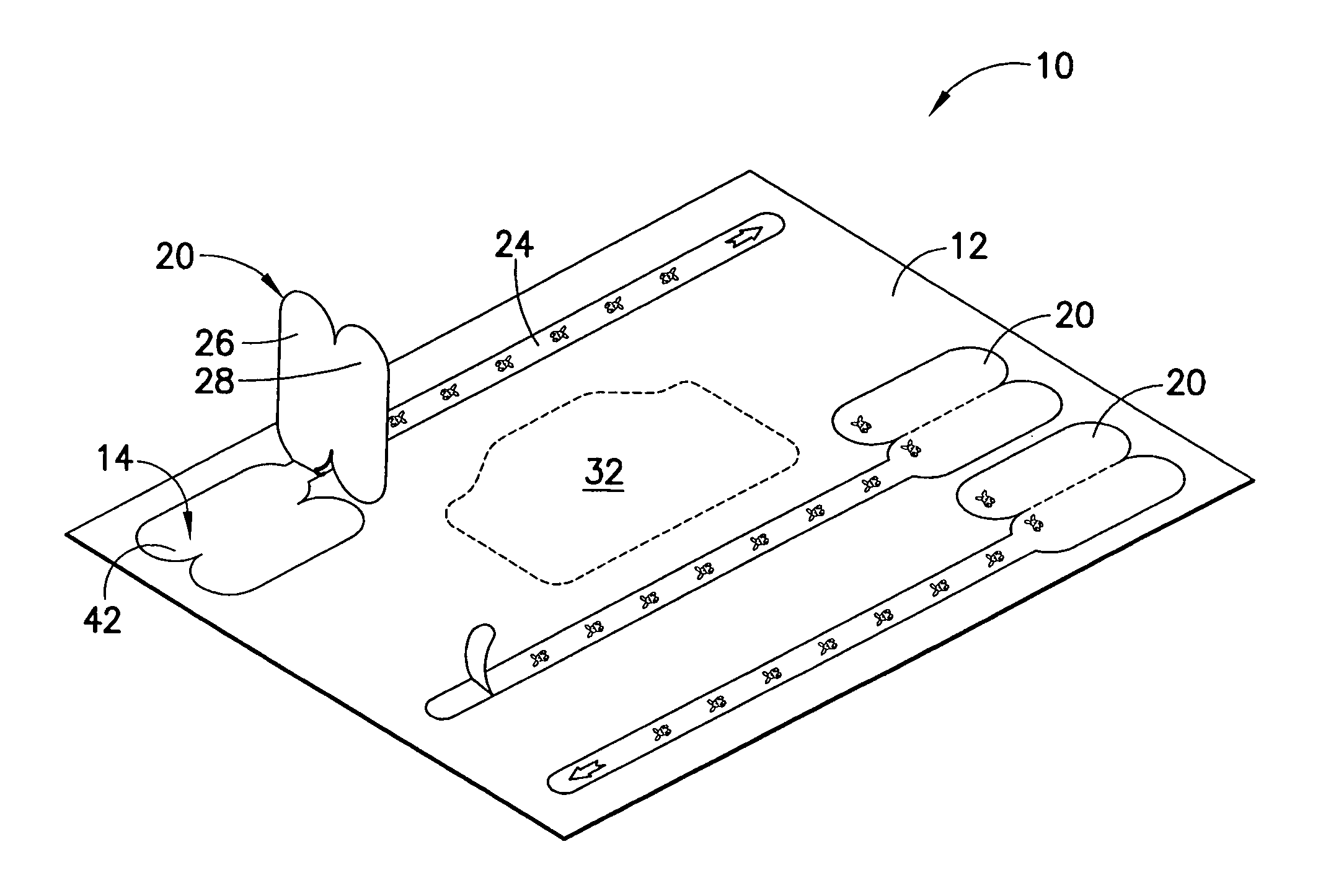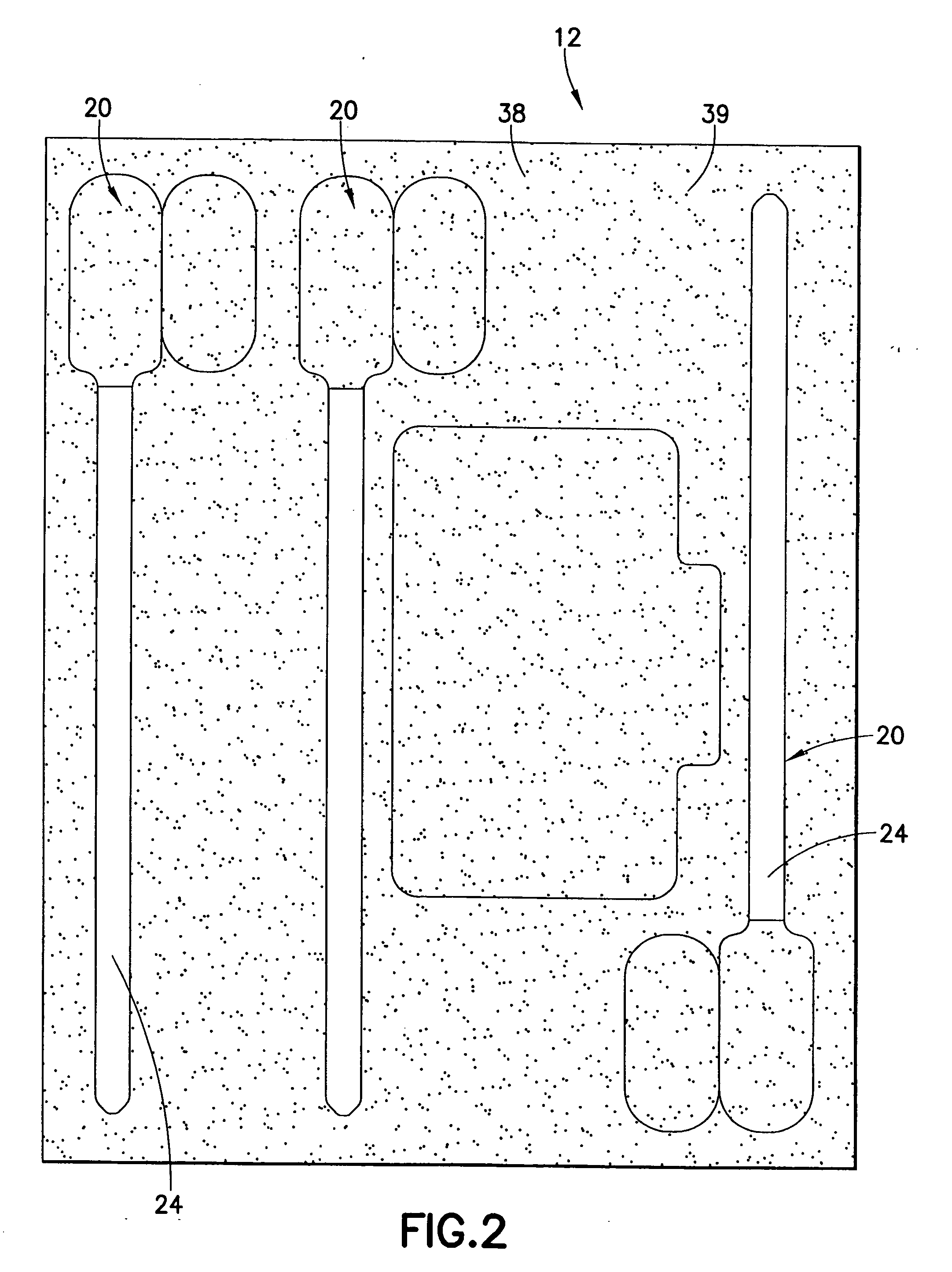[0015] The invention relates to an identification band suitable for carrying and displaying indicia and suitable for being worn on the
wrist or
ankle of an infant or other person. The identification band is formed from a thin flexible layer of woven material, and preferably is formed from a material that will permanently and clearly display indicia imparted thereon by a commercially available printer, such as a
laser printer, inkjet printer, thermal printer or the like. The woven material preferably is a woven synthetic fabric, such as
polyester or nylon. Additionally, the
woven fabric may be impregnated with a compatible synthetic material that will substantially fill voids between the woven fibers of the fabric to define a sufficiently continuous and
smooth surface for receiving and displaying printed indicia. The synthetic material impregnated into the
woven fabric may be a
polyester,
styrene, acrylic or other compatible organic-based material. The identification band in accordance with the invention preferably is sufficiently thin and flexible to avoid irritating
sensitive skin. For example, a
sheet material with a thickness of about 3.0-6.0 mils is preferred, and most preferably the material has a thickness of about 4.0 mils.
[0016] Identification bands in accordance with the subject invention are particularly well suited for infants, children and especially for prematurely born infants who will remain in a healthcare facility for several days, weeks or months. Narrow width bands are especially well suited for the small wrists or ankles of infants. However, a
narrow band may not have sufficient dimensions for receiving all of the identification information that is required. As a result, the identification band includes a narrow strap and an identification panel. The strap is sufficiently wide to provide the necessary strength and to prevent
biting into the
wrist or
ankle of the patient. Additionally, the strap preferably is wide enough to prevent twisting during normal use. A strap of approximately 1 cm wide is sufficient for these purposes. The identification panel is sufficiently wide and long to accommodate the identification indicia that may be required. For example, an identification panel with a width of about 2-3 cm and a length of about 5 cm is sufficiently large to convey the required indicia with adequate size and
clarity. The identification panel preferably is unitary with one longitudinal end of the strap, and preferably is free of sharp corners. The identification panel includes a top surface on which the identification indicia may be printed and an opposite back surface. The back surface need not be printed with identification indicia.
[0018] A layer of
pressure sensitive adhesive is applied to the back surface of the flap and / or the back surface of the identification panel. With this construction, the strap can be formed into a loop so that a section of the strap is placed in face-to-face engagement with the back surface of the identification panel. The flap then is folded so that the back surface of the flap overlies the back surface of the identification panel and sandwiches a portion of the strap between the back surfaces of the identification panel and the flap. The
adhesive applied to the back surface of the flap and / or the identification panel will securely retain the strap in its looped condition to form a continuous identification band. Although the strap is appropriately narrow for an infant, the identification panel is sufficiently large to bear the required identification indicia. Additionally, identification indicia on the flap will ensure that the identification data are easily readable even if the identification band becomes twisted slightly while worn. RFID HF or UHF inlay (such as Texas instruments Tag it or Avery Dennison's UHF) may also be inserted during manufacturing to reside between the laminate
layers or separate from band of which the inlay
label would be affixed prior to folding, thereby securing the inlay safely, securely and permanently between or on topside of the folds. In addition, the compressible nature of the woven fabric provides a protective
cushion around the RFID to help it
resist damage and can be made waterproof to further protect the identification band or RFID inlay as well.
[0019] An important aspect of the invention is the ability to print the identification band efficiently and reliably in a
laser printer, thermal, an inkjet printer or other commercially available printing apparatus. Printers work best when the printed sheets are relatively thin and have uniform thickness or coplanarity across the length and width of the sheet. Sheets that are too thick may not feed well in many machines and sheets that do not exhibit coplanarity across the sheet are likely to jam in the feed mechanisms of the printer.
 Login to View More
Login to View More  Login to View More
Login to View More 


